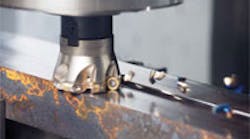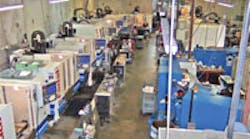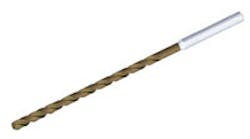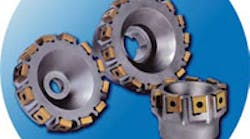Round cutters from Seco Tools Inc. (www.secotools.com) are suitable for roughing, semi-finishing and finishing.
Button cutters, or copy mills with round inserts, offer a number of advantages – especially in shops with limited-horsepower machine tools.
Owing to recent design improvements, round cutters:
- are no longer limited to light-cutting applications
- can handle difficult machining operations, such as circular and helical interpolation, ramping, shoulder milling, slot milling, plunging and ramping, in a variety of materials.
A major advantage of button cutters with round inserts is their high edge strength. The weakest section of a milling insert is the corner that is constantly exposed to interrupted cuts and heat changes, making it more likely to break.
With no corners to break, a round insert provides the strongest cutting edge available on a carbide insert. This strength gives a button cutter the ability to handle all types of materials and operations.
Button heads offered in modular two-piece endmills for moldand- die operations use round inserts that can handle facing, ramping and even plunging. When machining deep, enclosed cavities, these tools can run at up to four times the metalremoval rates of other ballnose endmills.
The inserts’ round shape also distributes cutting forces more evenly. A typical squareshoulder endmill enters the workpiece at a 90- degree angle, causing radial pressure on the tool and increased risk of tool breakage. A round insert has no true lead angle as it changes with a varying depth of cut. As the lead angle changes, the cutting forces change.
The optimal parameters for round cutters – including a tendency for a lower depth of cut – produce low radial forces, an even distribution of forces and conversion of a large part of the radial force into the axial direction. This helps reduce vibration to increase tool life and component quality.
Another advantage is that round inserts allow use of more edges, resulting in up to twice the material removal of a typical square-edged insert. This means:
- fewer inserts per operation
- reduced inventory
- lower cost per cutting edge
- improved operator efficiency due to fewer tool changes.
Button cutters really shine on light-duty machines with high-speed capability but limited horsepower. The strength of round inserts allows for high feed rates that would be impossible with a 90-degree cutting tool. However, obtaining a high feed rate requires a shallow depth of cut, which can cause chip thinning.
Dealing with the tradeoffs
Heavy cut depths can be achieved with button cutters, but that also increases chip thickness, resulting in higher cutting forces and reduced reduced tool life.
Other potential problem areas with button cutters include securing the insert in the seat.
Older designs featured both body and insert configurations with a flat to prevent rotation, but runout often occurred due to seating positioning.
In the past, manufacturers offered body designs without a flat for use with hexagonal inserts. This provided better seating positioning and less run out, but the hexagon-shaped inserts had a long overhang.
Also, in some instances, an octagon-shaped integrated anvil produced a tilting motion that could reduce the lock reserve, damage the seating face and allowing the insert to rock and rotate.
One example of a manufacturer addressing these issues comes from Seco Tools Inc. (www.secotools.com), which has introduced a family of round cutters suitable for roughing, semi-finishing and finishing in both face and copy-milling applications.
Redesign of the pocket in the cutter body improves axial support of the seat and provides stronger lock reserve. This results in high reliability and reduces the risk of insert and/or pocket-seat breakage.
Seco’s round inserts also have been redesigned with an integrated round anvil shape and anvil height to provide for more cutting edges, additional stability and secure locking of the inserts – thus preventing tilting and pocket seat damage.





